Classic Bike Frames (pre-1970) larger than 22.5in
Post-1970 English, American and Japanese road frames have three pages. Classic Road pre-1970 frames, Classic Track & Road-Track, Lo-Pro & Retro TT, Italian, Touring, Track, and Continental frames each have their own special pages as do 'Bargain Basement' frames (those under £100).
All our categories can be found in the sub-menu below – clicking on the category you want look at will get you directly to that page.
PLEASE NOTE: I measure all British, American and Japanese frames in inches ctt (centre to top) and convert to the nearest cm, conversely I measure all European and Italian frames in centimetres ctc (centre to centre) and convert to the nearest 0.25in.
A problem with all frames measured ctt is that the top measuring point varies from maker to maker and I try and second guess where the maker intended his measurement to be to – some mean top of top top tube, others the very top of the seat lug, and others to the seat lug top line…
FRAME SIZING
Do not assume that you will need a frame sized the same as your modern one – either seat tube or top tube. Fashion plays a great part in frame design and sizing. In the early years of the 20th century frames were sized as large as possible with virtually no seatpost showing … by contrast riders were advised in the 1920s to have as small a frame as possible.
Race/road frames from the 1920s/early 1930s will generally be sized about 3–5cm smaller than a modern frame but with a much longer top tube and shorter stems. Towards the end of the 1930s larger frame sizes became fashionable – up to 2cm larger than a modern frame. Top tube lengths were still longer used with shorter stems. In the 1940s and 50s frames were sized a bit larger still – 3–4cm more than a modern frame still with longer top tubes and shorter stems. In the 1960s and 1970s frames gradually reduced in size until the late 1980s. At the same time top tubes began to get shorter and stems longer.
Standover height is NOT a useful method of frame sizing either with modern or old frames. Short legged riders will rarely have much or any clearance between the top tube and their crotch unless the frame has a sloping top tube design. Taller riders also face other problems. A complete guide to frame sizing for frames of different periods is impossible to detail here. For frames from the 1980s onwards I suggest buyers look at Dave Moulton’s contributions on frame sizing. Possibly start off with http://davesbikeblog.squarespace.com/blog/2006/2/27/a-different-thought-on-frame-sizing.html
and then look at: http://www.davemoultonregistry.com/MoultonFrameSizeChart
I am willing to advise any customer on frame sizing with older frames.
Featured Frames
British and American road frames smaller than 21.5in
British and American road frames 21.5in–22.5in
British and American road frames larger than 22.5in
Bargain Basement
Classic Road frames pre-1970 smaller than 21.5in
Classic Road frames pre-1970 21.5in–22.5in
Classic Road frames pre-1970 larger than 22.5in (look below)
Classic Track & Road-Track frames pre-1970
European frames 56cm or smaller
European frames larger than 56cm
Italian frames 56cm or smaller
Italian frames larger than 56cm
Lo-Pro & Retro Time Trial frames
Touring frames
Track frames

Please contact me at: hilarystone@hilarystone.com to check on availability and confirm shipping cost.

RORY O’BRIEN DB SPECIAL Early 1960s 23in
Seat Tube (ctt): 23in (58cm), 21.75in (55.5cm) ctc
Top Tube (ctc): 23in (58cm)
Rear dropout width: 118mm
Wheel size: 27in or Sprints/700C with a brake drop of 59mm
Frame tubing: Reynolds 531 double butted
Seatpost size: 27.2mm
A number of well known framebuilders built frames for Rory O’Brien’s shops in Manor Park and Romford – Ephgrave, Vic Edwards and Wally Green were probably the best known. The fastback seat lug design combined with an Italian style separate clip is also very unusual and is similar in concept to but different in detail to Philbrook’s fastback design for Meridian/Young’s frames. The frame and forks are in their excellent original paint and the decals are mostly complete – these date the frame to the early 1960s. The standard of construction is very high – it is extremely beautiful – just take a look at the lug shorelines and seatstay bridge. It has custom rear dropouts based upon Huret rear ends – the rear hanger was cut off and a Canmpag hanger brazed in its place and the slots shortened. I am sure this was done as part of the original frame build. It is thought that it might have been built by Vic Edwards and certainly apes Bill Philbrooks’ work for Young’s.
Further info on Rory O’Brien can be found at http://www.classiclightweights.co.uk/builders/r-o-b-builders.html and http://www.classiclightweights.co.uk/builders/rory-o%27brien-david-hull-builders.html
The paint and chrome appear to be original and in very good condition though quite of the decals have flaked off. £275
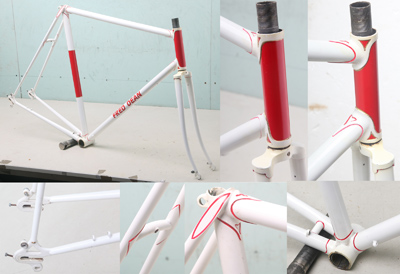
FRED DEAN ROAD FRAME 1963 23.5in
Seat Tube (ctt): 23.5in (59cm)
Top Tube (ctc): 22.5in (57cm)
Rear dropout width: 118mm
Wheel size: 27in or Sprints/700C with a brake drop of 62mm
Seatpost size: 27.2mm
Frame tubing: Reynolds 531 double butted
Fred Dean was a shop on York road in Wandsworth, south London that ran from 1957 until 1967. Like many shops he sourced his frames from a number of different builders and in my experience are not consistently numbered. There’s a lot more on Fred Dean at: http://www.classiclightweights.co.uk/builders/fred-dean-builders.html I think some of the very top frames were built by Bill Gray, I know some were built by Tom Board, others were supplied by Wally Green and others by Brian Packer. There were almost certainly others too. I would not know who built this one… Possibly it came from the Holdsworthy workshop judging by the fork crown. This one is in a number sequence I have seen a couple of times before – according to the article in Classic Lightweights this would date from 1963. Its been nicely repainted. £245
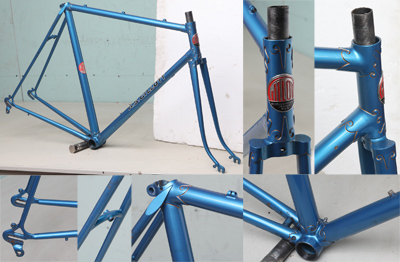
GILLOTT CURLY CUT TAPER TUBE ROAD FRAME 1947
Seat Tube (ctt): 23in (58cm)
Top Tube (ctc): 22.5in (57cm)
Rear dropout width: 120mm
Wheel size: 27in or Sprints/700C with a brake drop of 60mm
Seatpost size: 27.2mm
Frame tubing: Reynolds 531 taper tubing
Gillott frames are renowned for being built to consistently high standards – this was down to employing excellent framebuilders and Harry Carrington who was stickler for quality. More on Gilott can be found at: http://www.classiclightweights.co.uk/gillott.html
The curly cut lugged frames are really rare; I think there’s only one other one known built with taper tubing… This is the holy grail of Gillott frames… It's in in excellent condition and ready to be built up… £725
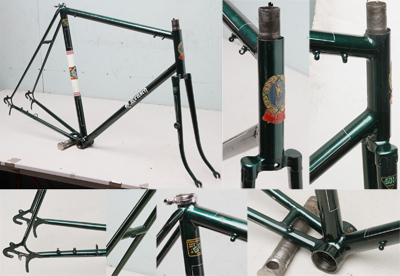
RENSCH PROFESSIONAL 1945–6 23in
Seat Tube (ctt): 23in (58cm), 22in (56cm) ctc
Top Tube (ctc): 22.25in (56.5cm)
Rear dropout width: 120mm
Wheel size: 27s or 700C/sprints with a brake drop of 62mm
Seatpost size: 26.4mm
Frame tubing: Not Known
Paris Cycles was founded in 1936 by Harry Rensch but it wasn’t until 1942/3 that they called themselves Paris Cycles. Previously they were simply known as Rensch Cycles. By 1945 were established at 131 Stoke Newington Church Street in North London.
There’s lots more on Paris and Rensch at http://www.classiclightweights.co.uk/Paris.html
This frame dates I think from about 1945–6 and is I think the Professional model – it has Osgear rear dropouts and a 1 1/8in top tube. Its been nicely repainted and is ready to be built up. £295
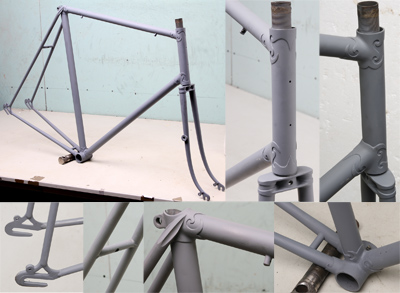
HETCHINS EXPERTO CREDE 1957 24.5in
Seat Tube (ctt): 24.5in (62cm)
Top Tube (ctc): 22.5in (57cm)
Rear dropout width: 120mm
Wheel size: 27s or 700C/sprints with a brake drop of 63mm
Seatpost size: 27.2mm
Frame tubing: Reynolds 531 double butted
I always think the slightly more restrained Experto Crede lug design is one of the most attractive of the numerous lug patterns that Hetchins used. Lots more on Hetchins can be found at: http://www.hetchins.org
This Experto Crede road frame from 1957 is in excellent condition and has been given a coat of primer ready for a new owner to decide upon the colour scheme they would like. £495
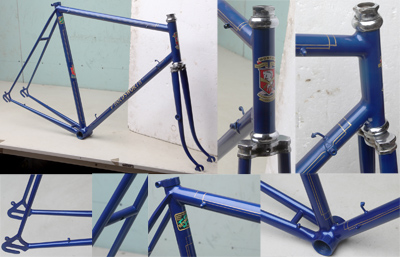
HOLDSWORTH LA QUELDA 23in 1948
Seat Tube (ctt): 23in (58cm)
Top Tube (ctc): 22.25in (56.5cm)
Rear dropout width: 110mm
Wheel size: 27s or Sprints/700C with a brake drop of 60mm
Frame tubing: Reynolds 531 double butted
Seatpost size: 27.2mm
The La Quelda model was Holdsworth’s ‘welded’ model introduced just before WWII when it was in fact actually welded. Post-war the welded look was retained but the tubes were joined with fillet brazing. This frame is thought to have been built by Bill Hurlow – it has an H before the frame number…
It has been nicely repainted with double box lining and is dent free… £265

Featured Frames
British and American road frames smaller than 21.5in
British and American road frames 21.5in–22.5in
British and American road frames larger than 22.5in
Bargain Basement
Classic Road frames pre-1970 smaller than 21.5in
Classic Road frames pre-1970 21.5in–22.5in
Classic Road frames pre-1970 larger than 22.5in (look above)
Classic Track & Road-Track frames pre-1970
European frames 56cm or smaller
European frames larger than 56cm
Italian frames 56cm or smaller
Italian frames larger than 56cm
Lo-Pro & Retro Time Trial frames
Touring frames
Track frames


|

SHIPPING COSTS
UK: £18
Europe: £35
North America: £90
Japan, Asia, Australasia, Africa, Middle East, South America: £115
Figures above are good estimates, rates may vary for some countries.
Contact us for more info.
CLICK ON the sale images to see a much larger picture!
FRAME CONDITION
Frames are supplied as seen in the pictures unless described otherwise in the text.
Please remember that these frames are generally at least twenty years old and sometimes seventy… In most cases I will know very little of their history but will attempt to describe any problems I can spot – if there are issues I have missed I will always work with the buyer to find a solution.
All frames I sell are in track and straight, with excellent headset threads, bottom bracket shell threads and gear hanger threads if fitted.
I will make every attempt to ascertain whether paint is original, an older repaint or a more recent repaint. Paint quality does vary quite bit…
These categories may be qualified by more detailed description in the text.
Excellent A very useable frame with no obtrusive marks to the paint and no dings or dents. Chrome if present will be free of serious marks unless stated otherwise.
Very Good Perfectly useable frame but with more marks to the paint and chrome if present. Some of the marks may benefit from careful retouching. Generally there will no dents or dings but if present will be small. However if you are concerned about dents/dings with frames in this category please ask me to do an extra check.
Sound Paint and chrome may need redoing depending on how you like your bikes – I appreciate frames with patina which show their age but others may want to repaint. There may be a small ding or two but nothing very significant – older frames often pick up smaller dents which are of no significance to their strength or life. Any more significant dents will be described in the text.
Needing repainting Paint will be poor and in my opinion is not saveable. There may be a small ding or two but nothing very significant – older frames often pick up smaller dents which are of no significance to their strength or life. If there are larger dents they will be described and/or pictured. These are all easily filled by a good framebuilder or frame painter at very little extra cost.
Headsets or bottom brackets fitted to frames are of unknown and unguaranteed condition unless specifically described in the text. Sometimes headsets or bottom brackets will not feel smooth and simply need a service and on other occasions the headset or bottom bracket will need replacing…
For frame without headsets or where you'd like a headset replaced I can offer a fitting service for £15. Please see the headset pages: http://hilarystone.com/headset.html for what is available but please bear in mind that you may need advice on whether a particular headset will fit your frame especially in relation to stack height.
|







